An Investigation into the Failures of the NPfiT Program and Strategies
VerifiedAdded on 2020/05/08
|13
|4985
|65
Report
AI Summary
This report provides a comprehensive analysis of the National Programme for IT (NPfiT) in the NHS, examining the factors that led to its ultimate failure. The report delves into organizational strategy and program alignment, highlighting the importance of a clear vision and strategic planning. It explores the program business case, program roadmap, and environmental assessment, identifying critical shortcomings in these areas. The report also investigates benefits management, stakeholder engagement, and program governance, revealing how failures in these areas contributed to the program's demise. Key issues discussed include a lack of strategic planning, poor risk assessment, inadequate stakeholder consultation, and issues with data security. The report concludes by emphasizing the need for effective planning, risk control measures, and stakeholder engagement to ensure the success of large-scale IT programs. The analysis draws on numerous academic sources, providing a well-rounded understanding of the NPfiT program's challenges and failures.

PROGRAM
MANAGEMENT
MANAGEMENT
Paraphrase This Document
Need a fresh take? Get an instant paraphrase of this document with our AI Paraphraser

TABLE OF CONTENTS
INTRODUCTION......................................................................................................................3
ORGANISATIONAL STRATEGY AND PROGRAM ALIGNMENT...................................3
Program business case............................................................................................................4
PROGRAM ROADMAP...........................................................................................................5
ENVIRONMENTAL ASSESSMENT.......................................................................................6
Benefits management.............................................................................................................7
Benefits identification and planning......................................................................................8
Stakeholder engagement........................................................................................................8
Program governance...............................................................................................................9
Program life cycle management.............................................................................................9
REFERENCES.........................................................................................................................11
INTRODUCTION......................................................................................................................3
ORGANISATIONAL STRATEGY AND PROGRAM ALIGNMENT...................................3
Program business case............................................................................................................4
PROGRAM ROADMAP...........................................................................................................5
ENVIRONMENTAL ASSESSMENT.......................................................................................6
Benefits management.............................................................................................................7
Benefits identification and planning......................................................................................8
Stakeholder engagement........................................................................................................8
Program governance...............................................................................................................9
Program life cycle management.............................................................................................9
REFERENCES.........................................................................................................................11
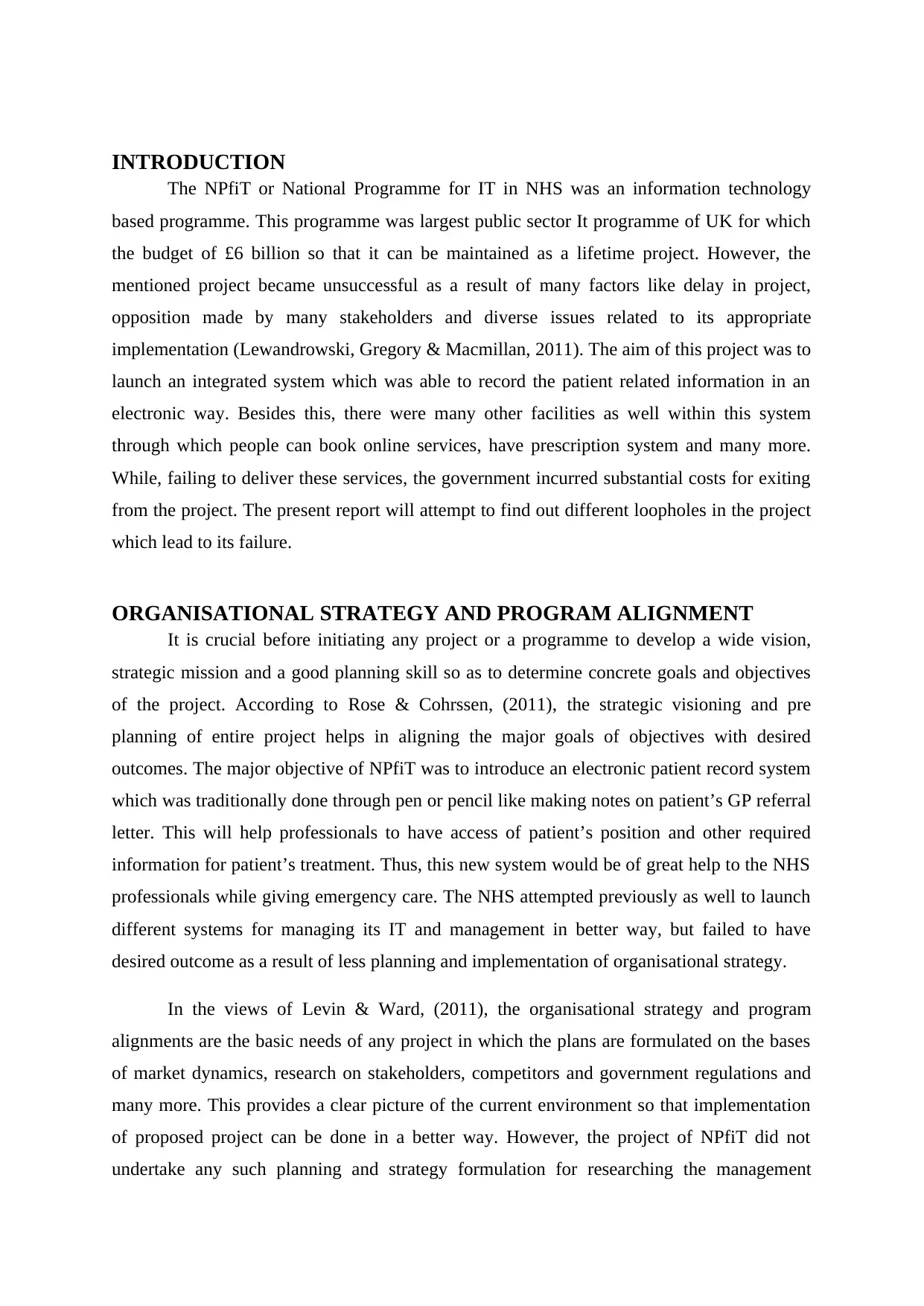
INTRODUCTION
The NPfiT or National Programme for IT in NHS was an information technology
based programme. This programme was largest public sector It programme of UK for which
the budget of £6 billion so that it can be maintained as a lifetime project. However, the
mentioned project became unsuccessful as a result of many factors like delay in project,
opposition made by many stakeholders and diverse issues related to its appropriate
implementation (Lewandrowski, Gregory & Macmillan, 2011). The aim of this project was to
launch an integrated system which was able to record the patient related information in an
electronic way. Besides this, there were many other facilities as well within this system
through which people can book online services, have prescription system and many more.
While, failing to deliver these services, the government incurred substantial costs for exiting
from the project. The present report will attempt to find out different loopholes in the project
which lead to its failure.
ORGANISATIONAL STRATEGY AND PROGRAM ALIGNMENT
It is crucial before initiating any project or a programme to develop a wide vision,
strategic mission and a good planning skill so as to determine concrete goals and objectives
of the project. According to Rose & Cohrssen, (2011), the strategic visioning and pre
planning of entire project helps in aligning the major goals of objectives with desired
outcomes. The major objective of NPfiT was to introduce an electronic patient record system
which was traditionally done through pen or pencil like making notes on patient’s GP referral
letter. This will help professionals to have access of patient’s position and other required
information for patient’s treatment. Thus, this new system would be of great help to the NHS
professionals while giving emergency care. The NHS attempted previously as well to launch
different systems for managing its IT and management in better way, but failed to have
desired outcome as a result of less planning and implementation of organisational strategy.
In the views of Levin & Ward, (2011), the organisational strategy and program
alignments are the basic needs of any project in which the plans are formulated on the bases
of market dynamics, research on stakeholders, competitors and government regulations and
many more. This provides a clear picture of the current environment so that implementation
of proposed project can be done in a better way. However, the project of NPfiT did not
undertake any such planning and strategy formulation for researching the management
The NPfiT or National Programme for IT in NHS was an information technology
based programme. This programme was largest public sector It programme of UK for which
the budget of £6 billion so that it can be maintained as a lifetime project. However, the
mentioned project became unsuccessful as a result of many factors like delay in project,
opposition made by many stakeholders and diverse issues related to its appropriate
implementation (Lewandrowski, Gregory & Macmillan, 2011). The aim of this project was to
launch an integrated system which was able to record the patient related information in an
electronic way. Besides this, there were many other facilities as well within this system
through which people can book online services, have prescription system and many more.
While, failing to deliver these services, the government incurred substantial costs for exiting
from the project. The present report will attempt to find out different loopholes in the project
which lead to its failure.
ORGANISATIONAL STRATEGY AND PROGRAM ALIGNMENT
It is crucial before initiating any project or a programme to develop a wide vision,
strategic mission and a good planning skill so as to determine concrete goals and objectives
of the project. According to Rose & Cohrssen, (2011), the strategic visioning and pre
planning of entire project helps in aligning the major goals of objectives with desired
outcomes. The major objective of NPfiT was to introduce an electronic patient record system
which was traditionally done through pen or pencil like making notes on patient’s GP referral
letter. This will help professionals to have access of patient’s position and other required
information for patient’s treatment. Thus, this new system would be of great help to the NHS
professionals while giving emergency care. The NHS attempted previously as well to launch
different systems for managing its IT and management in better way, but failed to have
desired outcome as a result of less planning and implementation of organisational strategy.
In the views of Levin & Ward, (2011), the organisational strategy and program
alignments are the basic needs of any project in which the plans are formulated on the bases
of market dynamics, research on stakeholders, competitors and government regulations and
many more. This provides a clear picture of the current environment so that implementation
of proposed project can be done in a better way. However, the project of NPfiT did not
undertake any such planning and strategy formulation for researching the management
⊘ This is a preview!⊘
Do you want full access?
Subscribe today to unlock all pages.

Trusted by 1+ million students worldwide
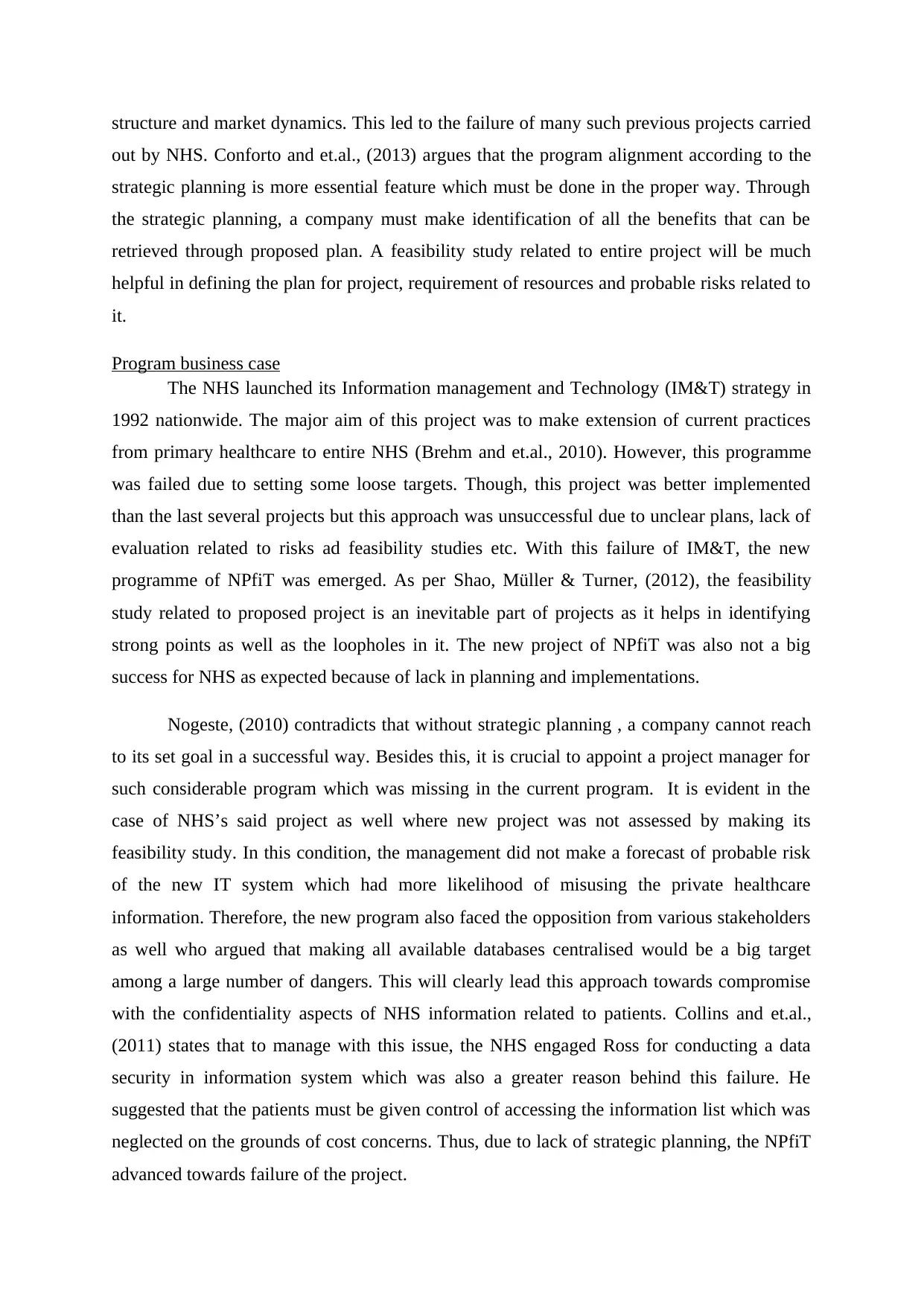
structure and market dynamics. This led to the failure of many such previous projects carried
out by NHS. Conforto and et.al., (2013) argues that the program alignment according to the
strategic planning is more essential feature which must be done in the proper way. Through
the strategic planning, a company must make identification of all the benefits that can be
retrieved through proposed plan. A feasibility study related to entire project will be much
helpful in defining the plan for project, requirement of resources and probable risks related to
it.
Program business case
The NHS launched its Information management and Technology (IM&T) strategy in
1992 nationwide. The major aim of this project was to make extension of current practices
from primary healthcare to entire NHS (Brehm and et.al., 2010). However, this programme
was failed due to setting some loose targets. Though, this project was better implemented
than the last several projects but this approach was unsuccessful due to unclear plans, lack of
evaluation related to risks ad feasibility studies etc. With this failure of IM&T, the new
programme of NPfiT was emerged. As per Shao, Müller & Turner, (2012), the feasibility
study related to proposed project is an inevitable part of projects as it helps in identifying
strong points as well as the loopholes in it. The new project of NPfiT was also not a big
success for NHS as expected because of lack in planning and implementations.
Nogeste, (2010) contradicts that without strategic planning , a company cannot reach
to its set goal in a successful way. Besides this, it is crucial to appoint a project manager for
such considerable program which was missing in the current program. It is evident in the
case of NHS’s said project as well where new project was not assessed by making its
feasibility study. In this condition, the management did not make a forecast of probable risk
of the new IT system which had more likelihood of misusing the private healthcare
information. Therefore, the new program also faced the opposition from various stakeholders
as well who argued that making all available databases centralised would be a big target
among a large number of dangers. This will clearly lead this approach towards compromise
with the confidentiality aspects of NHS information related to patients. Collins and et.al.,
(2011) states that to manage with this issue, the NHS engaged Ross for conducting a data
security in information system which was also a greater reason behind this failure. He
suggested that the patients must be given control of accessing the information list which was
neglected on the grounds of cost concerns. Thus, due to lack of strategic planning, the NPfiT
advanced towards failure of the project.
out by NHS. Conforto and et.al., (2013) argues that the program alignment according to the
strategic planning is more essential feature which must be done in the proper way. Through
the strategic planning, a company must make identification of all the benefits that can be
retrieved through proposed plan. A feasibility study related to entire project will be much
helpful in defining the plan for project, requirement of resources and probable risks related to
it.
Program business case
The NHS launched its Information management and Technology (IM&T) strategy in
1992 nationwide. The major aim of this project was to make extension of current practices
from primary healthcare to entire NHS (Brehm and et.al., 2010). However, this programme
was failed due to setting some loose targets. Though, this project was better implemented
than the last several projects but this approach was unsuccessful due to unclear plans, lack of
evaluation related to risks ad feasibility studies etc. With this failure of IM&T, the new
programme of NPfiT was emerged. As per Shao, Müller & Turner, (2012), the feasibility
study related to proposed project is an inevitable part of projects as it helps in identifying
strong points as well as the loopholes in it. The new project of NPfiT was also not a big
success for NHS as expected because of lack in planning and implementations.
Nogeste, (2010) contradicts that without strategic planning , a company cannot reach
to its set goal in a successful way. Besides this, it is crucial to appoint a project manager for
such considerable program which was missing in the current program. It is evident in the
case of NHS’s said project as well where new project was not assessed by making its
feasibility study. In this condition, the management did not make a forecast of probable risk
of the new IT system which had more likelihood of misusing the private healthcare
information. Therefore, the new program also faced the opposition from various stakeholders
as well who argued that making all available databases centralised would be a big target
among a large number of dangers. This will clearly lead this approach towards compromise
with the confidentiality aspects of NHS information related to patients. Collins and et.al.,
(2011) states that to manage with this issue, the NHS engaged Ross for conducting a data
security in information system which was also a greater reason behind this failure. He
suggested that the patients must be given control of accessing the information list which was
neglected on the grounds of cost concerns. Thus, due to lack of strategic planning, the NPfiT
advanced towards failure of the project.
Paraphrase This Document
Need a fresh take? Get an instant paraphrase of this document with our AI Paraphraser
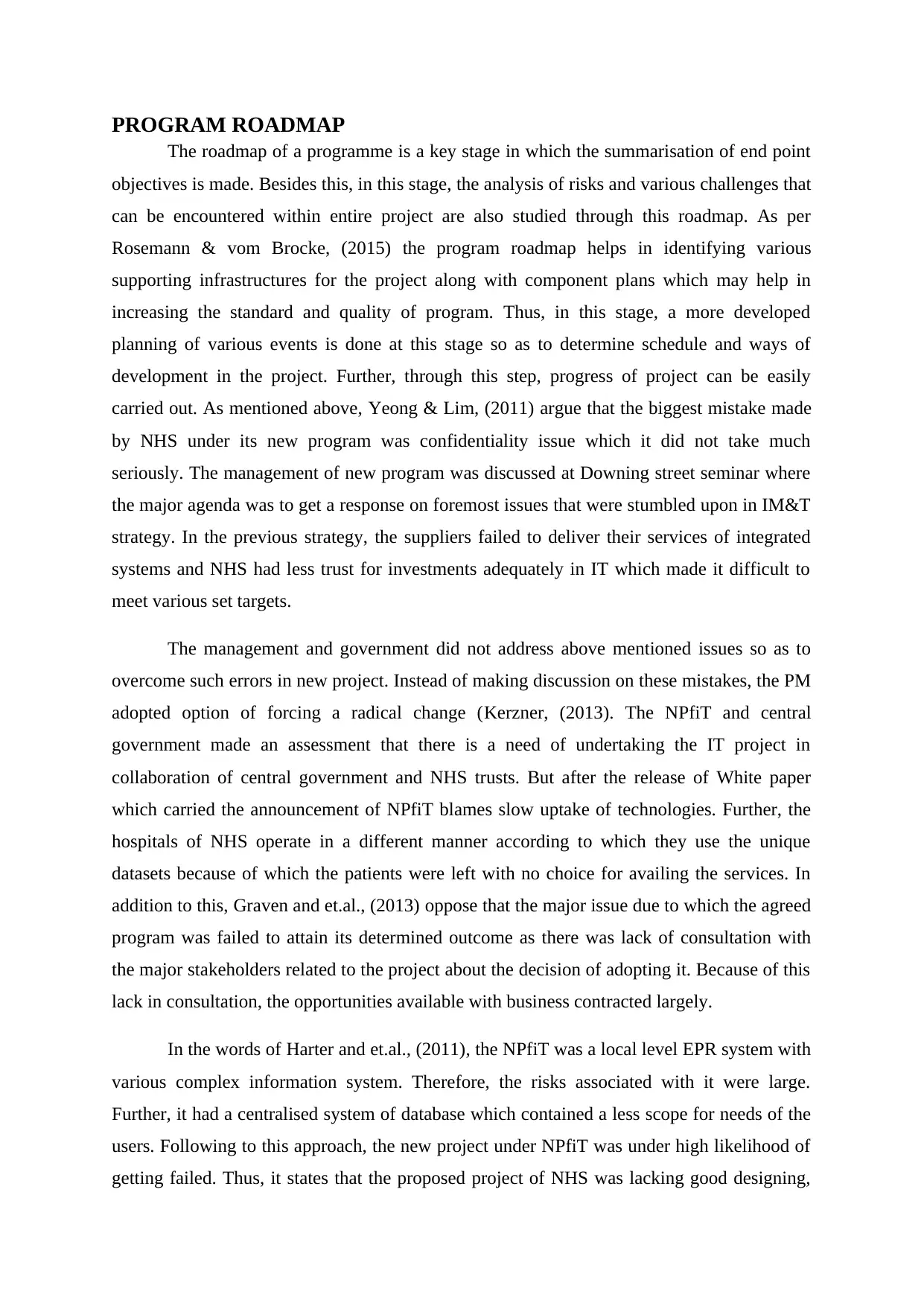
PROGRAM ROADMAP
The roadmap of a programme is a key stage in which the summarisation of end point
objectives is made. Besides this, in this stage, the analysis of risks and various challenges that
can be encountered within entire project are also studied through this roadmap. As per
Rosemann & vom Brocke, (2015) the program roadmap helps in identifying various
supporting infrastructures for the project along with component plans which may help in
increasing the standard and quality of program. Thus, in this stage, a more developed
planning of various events is done at this stage so as to determine schedule and ways of
development in the project. Further, through this step, progress of project can be easily
carried out. As mentioned above, Yeong & Lim, (2011) argue that the biggest mistake made
by NHS under its new program was confidentiality issue which it did not take much
seriously. The management of new program was discussed at Downing street seminar where
the major agenda was to get a response on foremost issues that were stumbled upon in IM&T
strategy. In the previous strategy, the suppliers failed to deliver their services of integrated
systems and NHS had less trust for investments adequately in IT which made it difficult to
meet various set targets.
The management and government did not address above mentioned issues so as to
overcome such errors in new project. Instead of making discussion on these mistakes, the PM
adopted option of forcing a radical change (Kerzner, (2013). The NPfiT and central
government made an assessment that there is a need of undertaking the IT project in
collaboration of central government and NHS trusts. But after the release of White paper
which carried the announcement of NPfiT blames slow uptake of technologies. Further, the
hospitals of NHS operate in a different manner according to which they use the unique
datasets because of which the patients were left with no choice for availing the services. In
addition to this, Graven and et.al., (2013) oppose that the major issue due to which the agreed
program was failed to attain its determined outcome as there was lack of consultation with
the major stakeholders related to the project about the decision of adopting it. Because of this
lack in consultation, the opportunities available with business contracted largely.
In the words of Harter and et.al., (2011), the NPfiT was a local level EPR system with
various complex information system. Therefore, the risks associated with it were large.
Further, it had a centralised system of database which contained a less scope for needs of the
users. Following to this approach, the new project under NPfiT was under high likelihood of
getting failed. Thus, it states that the proposed project of NHS was lacking good designing,
The roadmap of a programme is a key stage in which the summarisation of end point
objectives is made. Besides this, in this stage, the analysis of risks and various challenges that
can be encountered within entire project are also studied through this roadmap. As per
Rosemann & vom Brocke, (2015) the program roadmap helps in identifying various
supporting infrastructures for the project along with component plans which may help in
increasing the standard and quality of program. Thus, in this stage, a more developed
planning of various events is done at this stage so as to determine schedule and ways of
development in the project. Further, through this step, progress of project can be easily
carried out. As mentioned above, Yeong & Lim, (2011) argue that the biggest mistake made
by NHS under its new program was confidentiality issue which it did not take much
seriously. The management of new program was discussed at Downing street seminar where
the major agenda was to get a response on foremost issues that were stumbled upon in IM&T
strategy. In the previous strategy, the suppliers failed to deliver their services of integrated
systems and NHS had less trust for investments adequately in IT which made it difficult to
meet various set targets.
The management and government did not address above mentioned issues so as to
overcome such errors in new project. Instead of making discussion on these mistakes, the PM
adopted option of forcing a radical change (Kerzner, (2013). The NPfiT and central
government made an assessment that there is a need of undertaking the IT project in
collaboration of central government and NHS trusts. But after the release of White paper
which carried the announcement of NPfiT blames slow uptake of technologies. Further, the
hospitals of NHS operate in a different manner according to which they use the unique
datasets because of which the patients were left with no choice for availing the services. In
addition to this, Graven and et.al., (2013) oppose that the major issue due to which the agreed
program was failed to attain its determined outcome as there was lack of consultation with
the major stakeholders related to the project about the decision of adopting it. Because of this
lack in consultation, the opportunities available with business contracted largely.
In the words of Harter and et.al., (2011), the NPfiT was a local level EPR system with
various complex information system. Therefore, the risks associated with it were large.
Further, it had a centralised system of database which contained a less scope for needs of the
users. Following to this approach, the new project under NPfiT was under high likelihood of
getting failed. Thus, it states that the proposed project of NHS was lacking good designing,
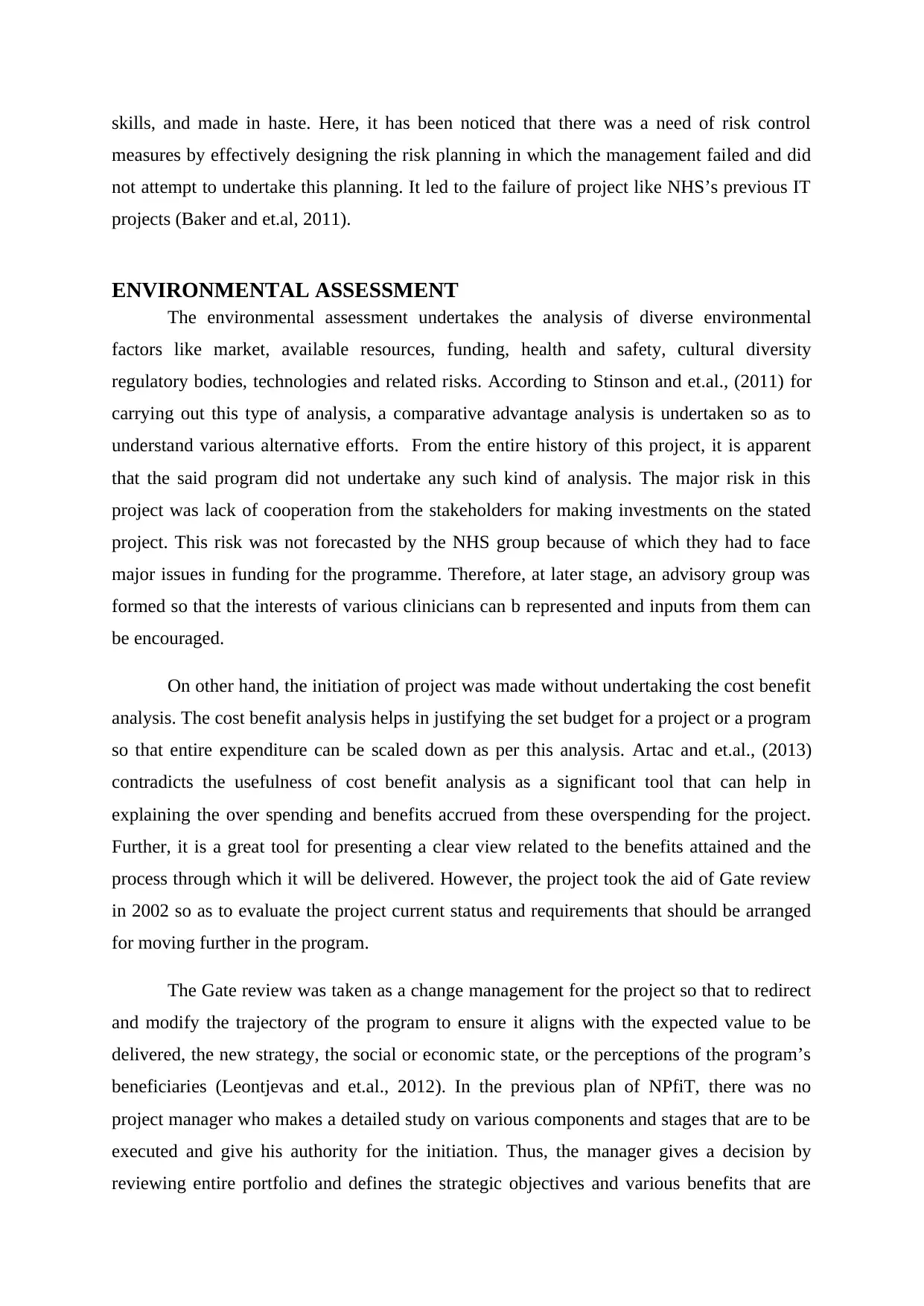
skills, and made in haste. Here, it has been noticed that there was a need of risk control
measures by effectively designing the risk planning in which the management failed and did
not attempt to undertake this planning. It led to the failure of project like NHS’s previous IT
projects (Baker and et.al, 2011).
ENVIRONMENTAL ASSESSMENT
The environmental assessment undertakes the analysis of diverse environmental
factors like market, available resources, funding, health and safety, cultural diversity
regulatory bodies, technologies and related risks. According to Stinson and et.al., (2011) for
carrying out this type of analysis, a comparative advantage analysis is undertaken so as to
understand various alternative efforts. From the entire history of this project, it is apparent
that the said program did not undertake any such kind of analysis. The major risk in this
project was lack of cooperation from the stakeholders for making investments on the stated
project. This risk was not forecasted by the NHS group because of which they had to face
major issues in funding for the programme. Therefore, at later stage, an advisory group was
formed so that the interests of various clinicians can b represented and inputs from them can
be encouraged.
On other hand, the initiation of project was made without undertaking the cost benefit
analysis. The cost benefit analysis helps in justifying the set budget for a project or a program
so that entire expenditure can be scaled down as per this analysis. Artac and et.al., (2013)
contradicts the usefulness of cost benefit analysis as a significant tool that can help in
explaining the over spending and benefits accrued from these overspending for the project.
Further, it is a great tool for presenting a clear view related to the benefits attained and the
process through which it will be delivered. However, the project took the aid of Gate review
in 2002 so as to evaluate the project current status and requirements that should be arranged
for moving further in the program.
The Gate review was taken as a change management for the project so that to redirect
and modify the trajectory of the program to ensure it aligns with the expected value to be
delivered, the new strategy, the social or economic state, or the perceptions of the program’s
beneficiaries (Leontjevas and et.al., 2012). In the previous plan of NPfiT, there was no
project manager who makes a detailed study on various components and stages that are to be
executed and give his authority for the initiation. Thus, the manager gives a decision by
reviewing entire portfolio and defines the strategic objectives and various benefits that are
measures by effectively designing the risk planning in which the management failed and did
not attempt to undertake this planning. It led to the failure of project like NHS’s previous IT
projects (Baker and et.al, 2011).
ENVIRONMENTAL ASSESSMENT
The environmental assessment undertakes the analysis of diverse environmental
factors like market, available resources, funding, health and safety, cultural diversity
regulatory bodies, technologies and related risks. According to Stinson and et.al., (2011) for
carrying out this type of analysis, a comparative advantage analysis is undertaken so as to
understand various alternative efforts. From the entire history of this project, it is apparent
that the said program did not undertake any such kind of analysis. The major risk in this
project was lack of cooperation from the stakeholders for making investments on the stated
project. This risk was not forecasted by the NHS group because of which they had to face
major issues in funding for the programme. Therefore, at later stage, an advisory group was
formed so that the interests of various clinicians can b represented and inputs from them can
be encouraged.
On other hand, the initiation of project was made without undertaking the cost benefit
analysis. The cost benefit analysis helps in justifying the set budget for a project or a program
so that entire expenditure can be scaled down as per this analysis. Artac and et.al., (2013)
contradicts the usefulness of cost benefit analysis as a significant tool that can help in
explaining the over spending and benefits accrued from these overspending for the project.
Further, it is a great tool for presenting a clear view related to the benefits attained and the
process through which it will be delivered. However, the project took the aid of Gate review
in 2002 so as to evaluate the project current status and requirements that should be arranged
for moving further in the program.
The Gate review was taken as a change management for the project so that to redirect
and modify the trajectory of the program to ensure it aligns with the expected value to be
delivered, the new strategy, the social or economic state, or the perceptions of the program’s
beneficiaries (Leontjevas and et.al., 2012). In the previous plan of NPfiT, there was no
project manager who makes a detailed study on various components and stages that are to be
executed and give his authority for the initiation. Thus, the manager gives a decision by
reviewing entire portfolio and defines the strategic objectives and various benefits that are
⊘ This is a preview!⊘
Do you want full access?
Subscribe today to unlock all pages.

Trusted by 1+ million students worldwide
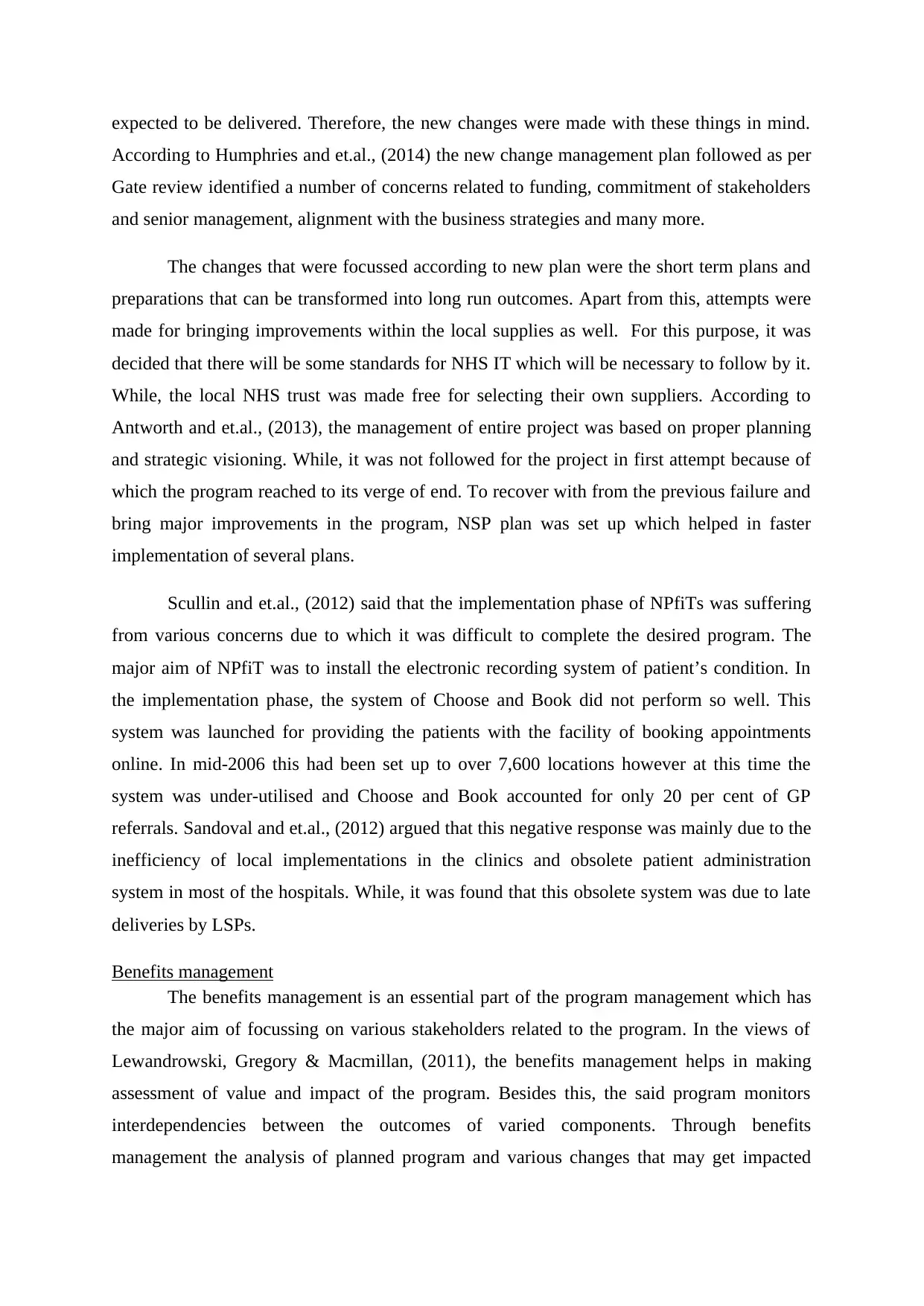
expected to be delivered. Therefore, the new changes were made with these things in mind.
According to Humphries and et.al., (2014) the new change management plan followed as per
Gate review identified a number of concerns related to funding, commitment of stakeholders
and senior management, alignment with the business strategies and many more.
The changes that were focussed according to new plan were the short term plans and
preparations that can be transformed into long run outcomes. Apart from this, attempts were
made for bringing improvements within the local supplies as well. For this purpose, it was
decided that there will be some standards for NHS IT which will be necessary to follow by it.
While, the local NHS trust was made free for selecting their own suppliers. According to
Antworth and et.al., (2013), the management of entire project was based on proper planning
and strategic visioning. While, it was not followed for the project in first attempt because of
which the program reached to its verge of end. To recover with from the previous failure and
bring major improvements in the program, NSP plan was set up which helped in faster
implementation of several plans.
Scullin and et.al., (2012) said that the implementation phase of NPfiTs was suffering
from various concerns due to which it was difficult to complete the desired program. The
major aim of NPfiT was to install the electronic recording system of patient’s condition. In
the implementation phase, the system of Choose and Book did not perform so well. This
system was launched for providing the patients with the facility of booking appointments
online. In mid-2006 this had been set up to over 7,600 locations however at this time the
system was under-utilised and Choose and Book accounted for only 20 per cent of GP
referrals. Sandoval and et.al., (2012) argued that this negative response was mainly due to the
inefficiency of local implementations in the clinics and obsolete patient administration
system in most of the hospitals. While, it was found that this obsolete system was due to late
deliveries by LSPs.
Benefits management
The benefits management is an essential part of the program management which has
the major aim of focussing on various stakeholders related to the program. In the views of
Lewandrowski, Gregory & Macmillan, (2011), the benefits management helps in making
assessment of value and impact of the program. Besides this, the said program monitors
interdependencies between the outcomes of varied components. Through benefits
management the analysis of planned program and various changes that may get impacted
According to Humphries and et.al., (2014) the new change management plan followed as per
Gate review identified a number of concerns related to funding, commitment of stakeholders
and senior management, alignment with the business strategies and many more.
The changes that were focussed according to new plan were the short term plans and
preparations that can be transformed into long run outcomes. Apart from this, attempts were
made for bringing improvements within the local supplies as well. For this purpose, it was
decided that there will be some standards for NHS IT which will be necessary to follow by it.
While, the local NHS trust was made free for selecting their own suppliers. According to
Antworth and et.al., (2013), the management of entire project was based on proper planning
and strategic visioning. While, it was not followed for the project in first attempt because of
which the program reached to its verge of end. To recover with from the previous failure and
bring major improvements in the program, NSP plan was set up which helped in faster
implementation of several plans.
Scullin and et.al., (2012) said that the implementation phase of NPfiTs was suffering
from various concerns due to which it was difficult to complete the desired program. The
major aim of NPfiT was to install the electronic recording system of patient’s condition. In
the implementation phase, the system of Choose and Book did not perform so well. This
system was launched for providing the patients with the facility of booking appointments
online. In mid-2006 this had been set up to over 7,600 locations however at this time the
system was under-utilised and Choose and Book accounted for only 20 per cent of GP
referrals. Sandoval and et.al., (2012) argued that this negative response was mainly due to the
inefficiency of local implementations in the clinics and obsolete patient administration
system in most of the hospitals. While, it was found that this obsolete system was due to late
deliveries by LSPs.
Benefits management
The benefits management is an essential part of the program management which has
the major aim of focussing on various stakeholders related to the program. In the views of
Lewandrowski, Gregory & Macmillan, (2011), the benefits management helps in making
assessment of value and impact of the program. Besides this, the said program monitors
interdependencies between the outcomes of varied components. Through benefits
management the analysis of planned program and various changes that may get impacted
Paraphrase This Document
Need a fresh take? Get an instant paraphrase of this document with our AI Paraphraser
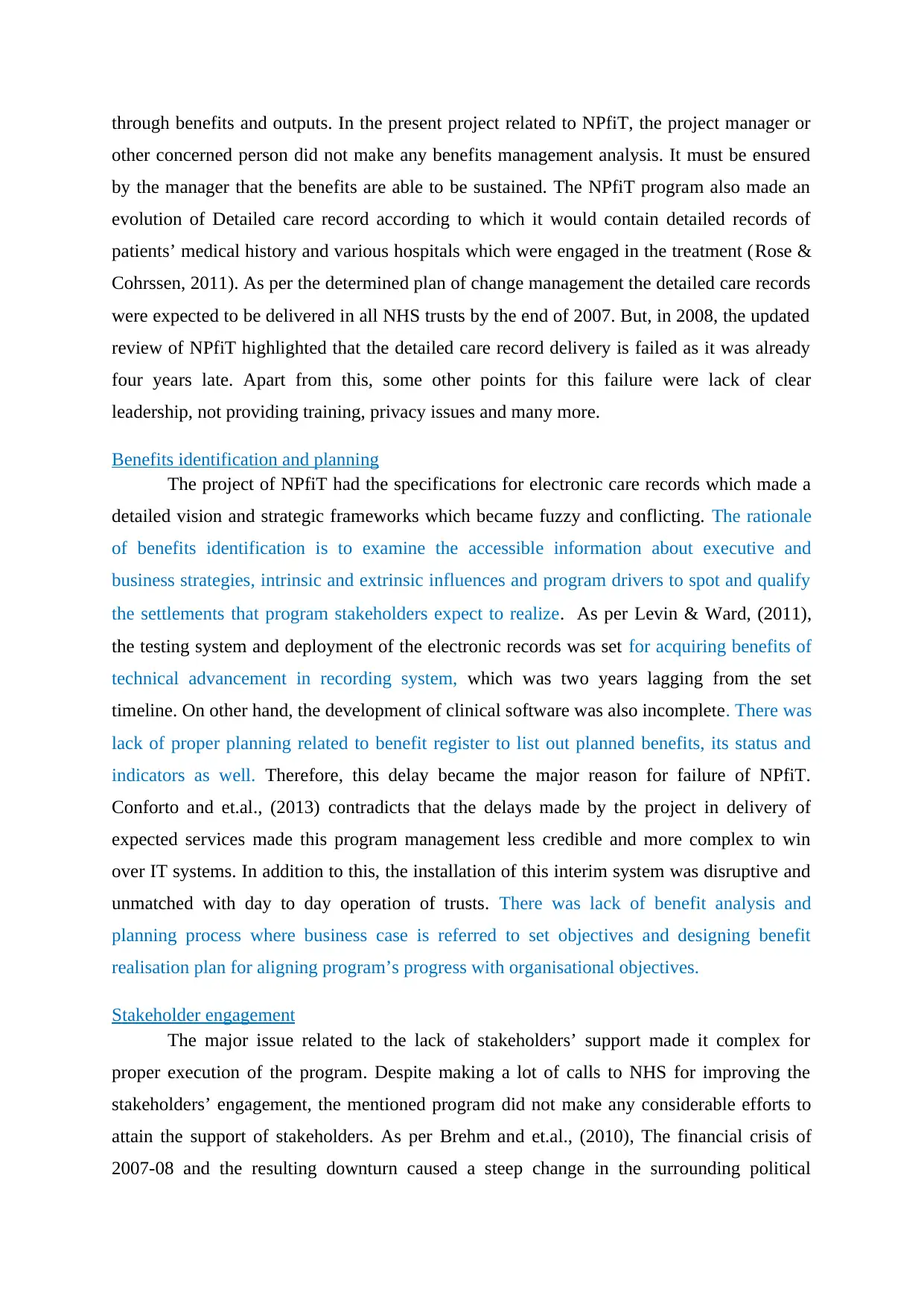
through benefits and outputs. In the present project related to NPfiT, the project manager or
other concerned person did not make any benefits management analysis. It must be ensured
by the manager that the benefits are able to be sustained. The NPfiT program also made an
evolution of Detailed care record according to which it would contain detailed records of
patients’ medical history and various hospitals which were engaged in the treatment (Rose &
Cohrssen, 2011). As per the determined plan of change management the detailed care records
were expected to be delivered in all NHS trusts by the end of 2007. But, in 2008, the updated
review of NPfiT highlighted that the detailed care record delivery is failed as it was already
four years late. Apart from this, some other points for this failure were lack of clear
leadership, not providing training, privacy issues and many more.
Benefits identification and planning
The project of NPfiT had the specifications for electronic care records which made a
detailed vision and strategic frameworks which became fuzzy and conflicting. The rationale
of benefits identification is to examine the accessible information about executive and
business strategies, intrinsic and extrinsic influences and program drivers to spot and qualify
the settlements that program stakeholders expect to realize. As per Levin & Ward, (2011),
the testing system and deployment of the electronic records was set for acquiring benefits of
technical advancement in recording system, which was two years lagging from the set
timeline. On other hand, the development of clinical software was also incomplete. There was
lack of proper planning related to benefit register to list out planned benefits, its status and
indicators as well. Therefore, this delay became the major reason for failure of NPfiT.
Conforto and et.al., (2013) contradicts that the delays made by the project in delivery of
expected services made this program management less credible and more complex to win
over IT systems. In addition to this, the installation of this interim system was disruptive and
unmatched with day to day operation of trusts. There was lack of benefit analysis and
planning process where business case is referred to set objectives and designing benefit
realisation plan for aligning program’s progress with organisational objectives.
Stakeholder engagement
The major issue related to the lack of stakeholders’ support made it complex for
proper execution of the program. Despite making a lot of calls to NHS for improving the
stakeholders’ engagement, the mentioned program did not make any considerable efforts to
attain the support of stakeholders. As per Brehm and et.al., (2010), The financial crisis of
2007-08 and the resulting downturn caused a steep change in the surrounding political
other concerned person did not make any benefits management analysis. It must be ensured
by the manager that the benefits are able to be sustained. The NPfiT program also made an
evolution of Detailed care record according to which it would contain detailed records of
patients’ medical history and various hospitals which were engaged in the treatment (Rose &
Cohrssen, 2011). As per the determined plan of change management the detailed care records
were expected to be delivered in all NHS trusts by the end of 2007. But, in 2008, the updated
review of NPfiT highlighted that the detailed care record delivery is failed as it was already
four years late. Apart from this, some other points for this failure were lack of clear
leadership, not providing training, privacy issues and many more.
Benefits identification and planning
The project of NPfiT had the specifications for electronic care records which made a
detailed vision and strategic frameworks which became fuzzy and conflicting. The rationale
of benefits identification is to examine the accessible information about executive and
business strategies, intrinsic and extrinsic influences and program drivers to spot and qualify
the settlements that program stakeholders expect to realize. As per Levin & Ward, (2011),
the testing system and deployment of the electronic records was set for acquiring benefits of
technical advancement in recording system, which was two years lagging from the set
timeline. On other hand, the development of clinical software was also incomplete. There was
lack of proper planning related to benefit register to list out planned benefits, its status and
indicators as well. Therefore, this delay became the major reason for failure of NPfiT.
Conforto and et.al., (2013) contradicts that the delays made by the project in delivery of
expected services made this program management less credible and more complex to win
over IT systems. In addition to this, the installation of this interim system was disruptive and
unmatched with day to day operation of trusts. There was lack of benefit analysis and
planning process where business case is referred to set objectives and designing benefit
realisation plan for aligning program’s progress with organisational objectives.
Stakeholder engagement
The major issue related to the lack of stakeholders’ support made it complex for
proper execution of the program. Despite making a lot of calls to NHS for improving the
stakeholders’ engagement, the mentioned program did not make any considerable efforts to
attain the support of stakeholders. As per Brehm and et.al., (2010), The financial crisis of
2007-08 and the resulting downturn caused a steep change in the surrounding political
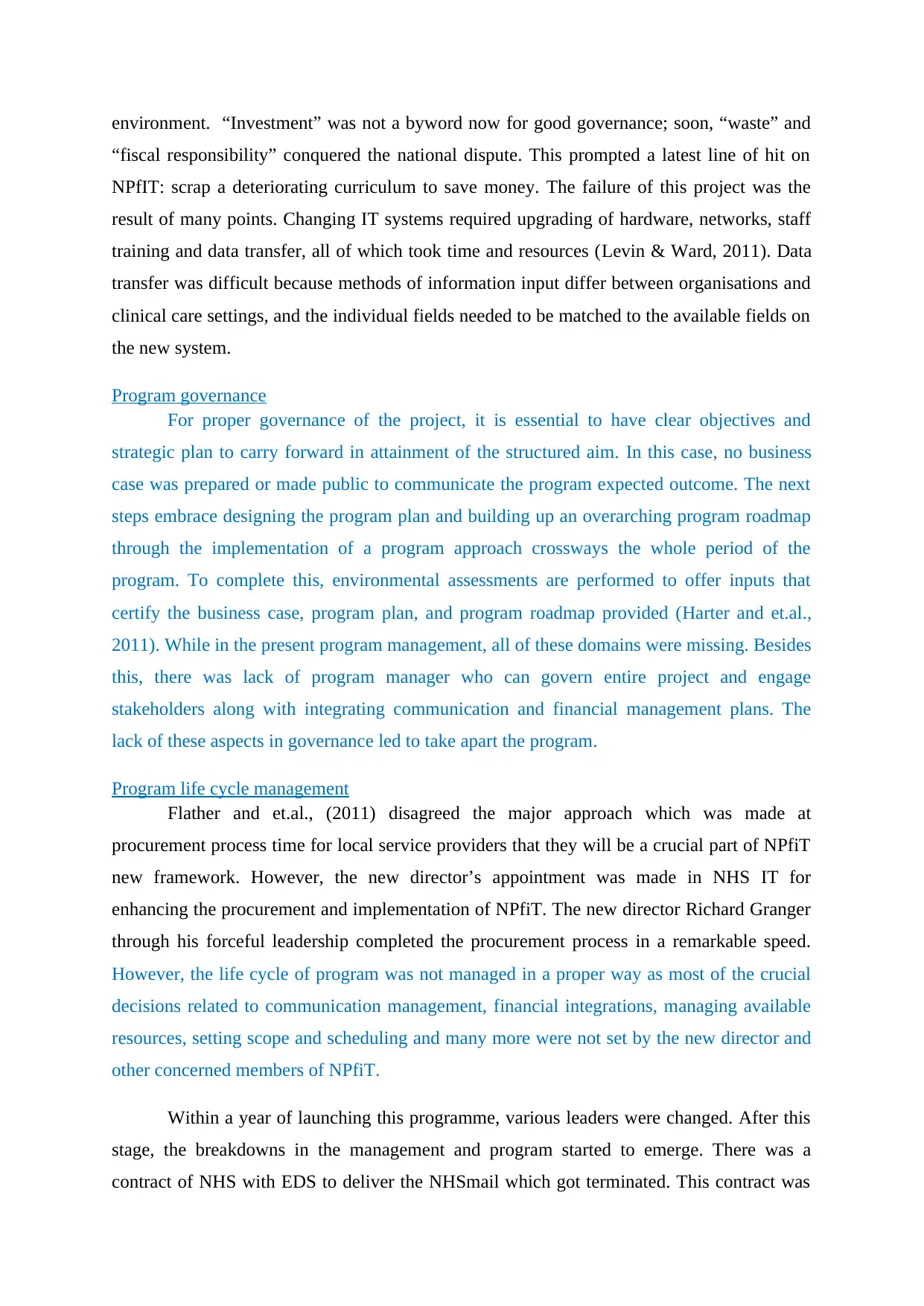
environment. “Investment” was not a byword now for good governance; soon, “waste” and
“fiscal responsibility” conquered the national dispute. This prompted a latest line of hit on
NPfIT: scrap a deteriorating curriculum to save money. The failure of this project was the
result of many points. Changing IT systems required upgrading of hardware, networks, staff
training and data transfer, all of which took time and resources (Levin & Ward, 2011). Data
transfer was difficult because methods of information input differ between organisations and
clinical care settings, and the individual fields needed to be matched to the available fields on
the new system.
Program governance
For proper governance of the project, it is essential to have clear objectives and
strategic plan to carry forward in attainment of the structured aim. In this case, no business
case was prepared or made public to communicate the program expected outcome. The next
steps embrace designing the program plan and building up an overarching program roadmap
through the implementation of a program approach crossways the whole period of the
program. To complete this, environmental assessments are performed to offer inputs that
certify the business case, program plan, and program roadmap provided (Harter and et.al.,
2011). While in the present program management, all of these domains were missing. Besides
this, there was lack of program manager who can govern entire project and engage
stakeholders along with integrating communication and financial management plans. The
lack of these aspects in governance led to take apart the program.
Program life cycle management
Flather and et.al., (2011) disagreed the major approach which was made at
procurement process time for local service providers that they will be a crucial part of NPfiT
new framework. However, the new director’s appointment was made in NHS IT for
enhancing the procurement and implementation of NPfiT. The new director Richard Granger
through his forceful leadership completed the procurement process in a remarkable speed.
However, the life cycle of program was not managed in a proper way as most of the crucial
decisions related to communication management, financial integrations, managing available
resources, setting scope and scheduling and many more were not set by the new director and
other concerned members of NPfiT.
Within a year of launching this programme, various leaders were changed. After this
stage, the breakdowns in the management and program started to emerge. There was a
contract of NHS with EDS to deliver the NHSmail which got terminated. This contract was
“fiscal responsibility” conquered the national dispute. This prompted a latest line of hit on
NPfIT: scrap a deteriorating curriculum to save money. The failure of this project was the
result of many points. Changing IT systems required upgrading of hardware, networks, staff
training and data transfer, all of which took time and resources (Levin & Ward, 2011). Data
transfer was difficult because methods of information input differ between organisations and
clinical care settings, and the individual fields needed to be matched to the available fields on
the new system.
Program governance
For proper governance of the project, it is essential to have clear objectives and
strategic plan to carry forward in attainment of the structured aim. In this case, no business
case was prepared or made public to communicate the program expected outcome. The next
steps embrace designing the program plan and building up an overarching program roadmap
through the implementation of a program approach crossways the whole period of the
program. To complete this, environmental assessments are performed to offer inputs that
certify the business case, program plan, and program roadmap provided (Harter and et.al.,
2011). While in the present program management, all of these domains were missing. Besides
this, there was lack of program manager who can govern entire project and engage
stakeholders along with integrating communication and financial management plans. The
lack of these aspects in governance led to take apart the program.
Program life cycle management
Flather and et.al., (2011) disagreed the major approach which was made at
procurement process time for local service providers that they will be a crucial part of NPfiT
new framework. However, the new director’s appointment was made in NHS IT for
enhancing the procurement and implementation of NPfiT. The new director Richard Granger
through his forceful leadership completed the procurement process in a remarkable speed.
However, the life cycle of program was not managed in a proper way as most of the crucial
decisions related to communication management, financial integrations, managing available
resources, setting scope and scheduling and many more were not set by the new director and
other concerned members of NPfiT.
Within a year of launching this programme, various leaders were changed. After this
stage, the breakdowns in the management and program started to emerge. There was a
contract of NHS with EDS to deliver the NHSmail which got terminated. This contract was
⊘ This is a preview!⊘
Do you want full access?
Subscribe today to unlock all pages.

Trusted by 1+ million students worldwide
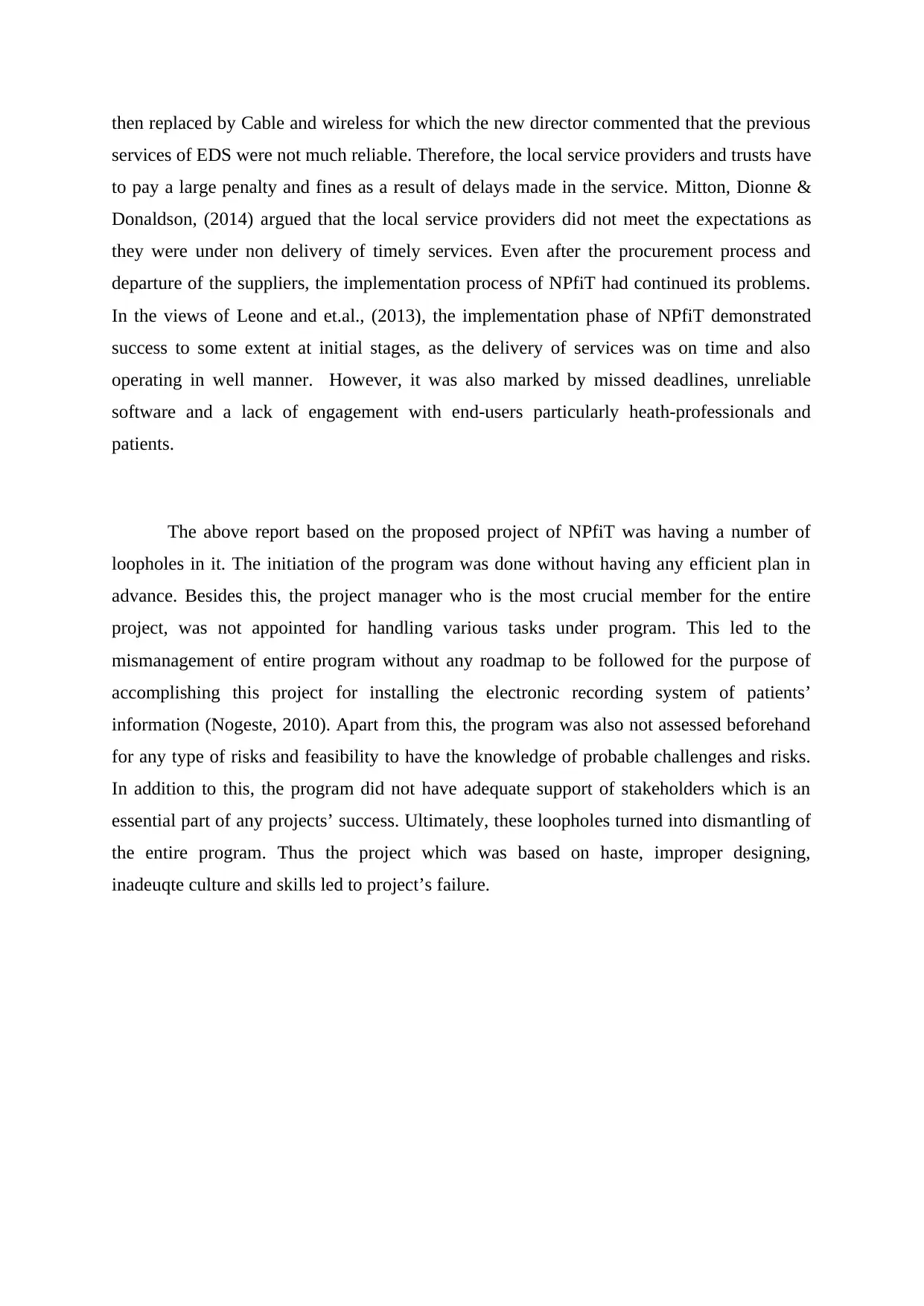
then replaced by Cable and wireless for which the new director commented that the previous
services of EDS were not much reliable. Therefore, the local service providers and trusts have
to pay a large penalty and fines as a result of delays made in the service. Mitton, Dionne &
Donaldson, (2014) argued that the local service providers did not meet the expectations as
they were under non delivery of timely services. Even after the procurement process and
departure of the suppliers, the implementation process of NPfiT had continued its problems.
In the views of Leone and et.al., (2013), the implementation phase of NPfiT demonstrated
success to some extent at initial stages, as the delivery of services was on time and also
operating in well manner. However, it was also marked by missed deadlines, unreliable
software and a lack of engagement with end-users particularly heath-professionals and
patients.
The above report based on the proposed project of NPfiT was having a number of
loopholes in it. The initiation of the program was done without having any efficient plan in
advance. Besides this, the project manager who is the most crucial member for the entire
project, was not appointed for handling various tasks under program. This led to the
mismanagement of entire program without any roadmap to be followed for the purpose of
accomplishing this project for installing the electronic recording system of patients’
information (Nogeste, 2010). Apart from this, the program was also not assessed beforehand
for any type of risks and feasibility to have the knowledge of probable challenges and risks.
In addition to this, the program did not have adequate support of stakeholders which is an
essential part of any projects’ success. Ultimately, these loopholes turned into dismantling of
the entire program. Thus the project which was based on haste, improper designing,
inadeuqte culture and skills led to project’s failure.
services of EDS were not much reliable. Therefore, the local service providers and trusts have
to pay a large penalty and fines as a result of delays made in the service. Mitton, Dionne &
Donaldson, (2014) argued that the local service providers did not meet the expectations as
they were under non delivery of timely services. Even after the procurement process and
departure of the suppliers, the implementation process of NPfiT had continued its problems.
In the views of Leone and et.al., (2013), the implementation phase of NPfiT demonstrated
success to some extent at initial stages, as the delivery of services was on time and also
operating in well manner. However, it was also marked by missed deadlines, unreliable
software and a lack of engagement with end-users particularly heath-professionals and
patients.
The above report based on the proposed project of NPfiT was having a number of
loopholes in it. The initiation of the program was done without having any efficient plan in
advance. Besides this, the project manager who is the most crucial member for the entire
project, was not appointed for handling various tasks under program. This led to the
mismanagement of entire program without any roadmap to be followed for the purpose of
accomplishing this project for installing the electronic recording system of patients’
information (Nogeste, 2010). Apart from this, the program was also not assessed beforehand
for any type of risks and feasibility to have the knowledge of probable challenges and risks.
In addition to this, the program did not have adequate support of stakeholders which is an
essential part of any projects’ success. Ultimately, these loopholes turned into dismantling of
the entire program. Thus the project which was based on haste, improper designing,
inadeuqte culture and skills led to project’s failure.
Paraphrase This Document
Need a fresh take? Get an instant paraphrase of this document with our AI Paraphraser
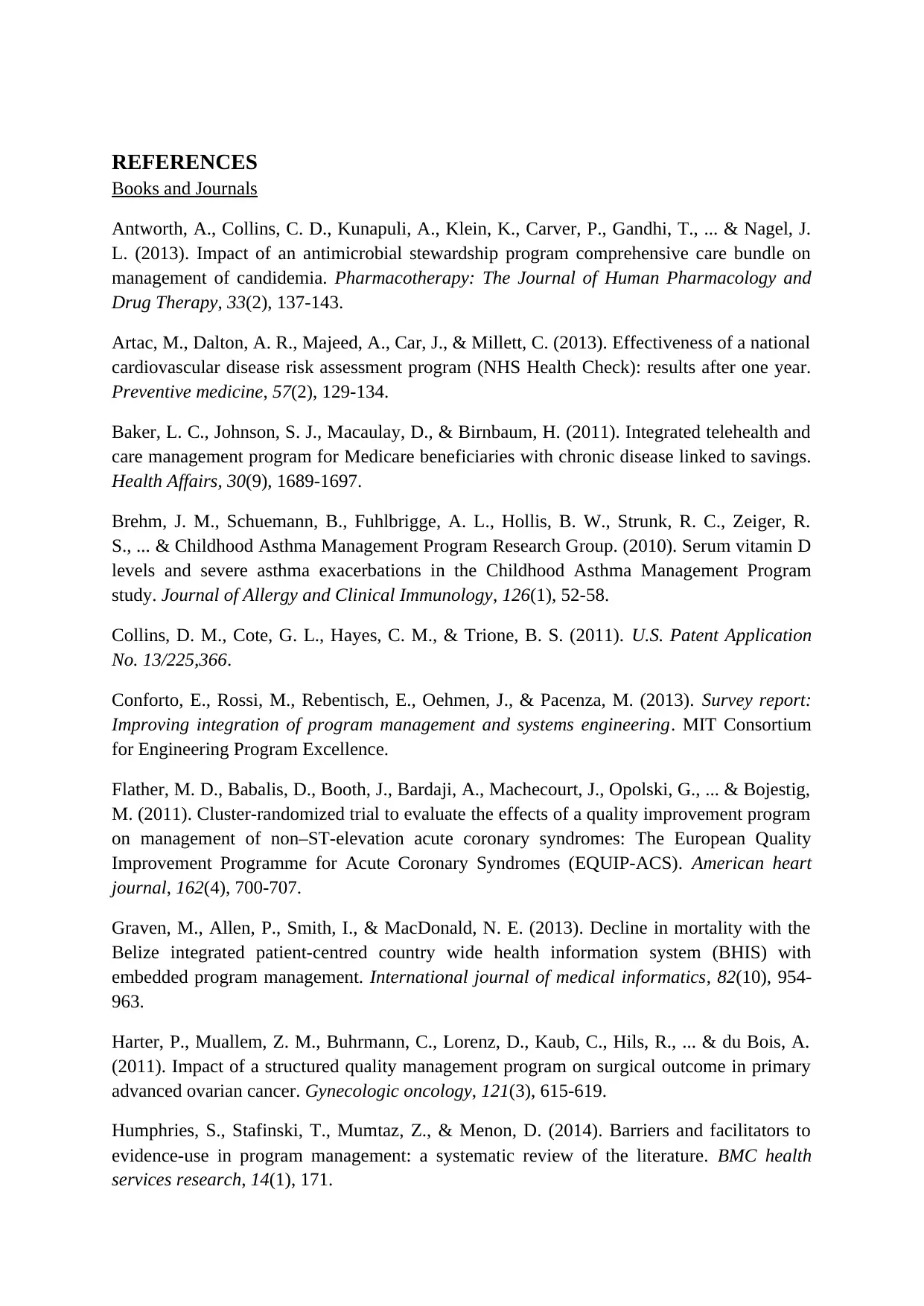
REFERENCES
Books and Journals
Antworth, A., Collins, C. D., Kunapuli, A., Klein, K., Carver, P., Gandhi, T., ... & Nagel, J.
L. (2013). Impact of an antimicrobial stewardship program comprehensive care bundle on
management of candidemia. Pharmacotherapy: The Journal of Human Pharmacology and
Drug Therapy, 33(2), 137-143.
Artac, M., Dalton, A. R., Majeed, A., Car, J., & Millett, C. (2013). Effectiveness of a national
cardiovascular disease risk assessment program (NHS Health Check): results after one year.
Preventive medicine, 57(2), 129-134.
Baker, L. C., Johnson, S. J., Macaulay, D., & Birnbaum, H. (2011). Integrated telehealth and
care management program for Medicare beneficiaries with chronic disease linked to savings.
Health Affairs, 30(9), 1689-1697.
Brehm, J. M., Schuemann, B., Fuhlbrigge, A. L., Hollis, B. W., Strunk, R. C., Zeiger, R.
S., ... & Childhood Asthma Management Program Research Group. (2010). Serum vitamin D
levels and severe asthma exacerbations in the Childhood Asthma Management Program
study. Journal of Allergy and Clinical Immunology, 126(1), 52-58.
Collins, D. M., Cote, G. L., Hayes, C. M., & Trione, B. S. (2011). U.S. Patent Application
No. 13/225,366.
Conforto, E., Rossi, M., Rebentisch, E., Oehmen, J., & Pacenza, M. (2013). Survey report:
Improving integration of program management and systems engineering. MIT Consortium
for Engineering Program Excellence.
Flather, M. D., Babalis, D., Booth, J., Bardaji, A., Machecourt, J., Opolski, G., ... & Bojestig,
M. (2011). Cluster-randomized trial to evaluate the effects of a quality improvement program
on management of non–ST-elevation acute coronary syndromes: The European Quality
Improvement Programme for Acute Coronary Syndromes (EQUIP-ACS). American heart
journal, 162(4), 700-707.
Graven, M., Allen, P., Smith, I., & MacDonald, N. E. (2013). Decline in mortality with the
Belize integrated patient-centred country wide health information system (BHIS) with
embedded program management. International journal of medical informatics, 82(10), 954-
963.
Harter, P., Muallem, Z. M., Buhrmann, C., Lorenz, D., Kaub, C., Hils, R., ... & du Bois, A.
(2011). Impact of a structured quality management program on surgical outcome in primary
advanced ovarian cancer. Gynecologic oncology, 121(3), 615-619.
Humphries, S., Stafinski, T., Mumtaz, Z., & Menon, D. (2014). Barriers and facilitators to
evidence-use in program management: a systematic review of the literature. BMC health
services research, 14(1), 171.
Books and Journals
Antworth, A., Collins, C. D., Kunapuli, A., Klein, K., Carver, P., Gandhi, T., ... & Nagel, J.
L. (2013). Impact of an antimicrobial stewardship program comprehensive care bundle on
management of candidemia. Pharmacotherapy: The Journal of Human Pharmacology and
Drug Therapy, 33(2), 137-143.
Artac, M., Dalton, A. R., Majeed, A., Car, J., & Millett, C. (2013). Effectiveness of a national
cardiovascular disease risk assessment program (NHS Health Check): results after one year.
Preventive medicine, 57(2), 129-134.
Baker, L. C., Johnson, S. J., Macaulay, D., & Birnbaum, H. (2011). Integrated telehealth and
care management program for Medicare beneficiaries with chronic disease linked to savings.
Health Affairs, 30(9), 1689-1697.
Brehm, J. M., Schuemann, B., Fuhlbrigge, A. L., Hollis, B. W., Strunk, R. C., Zeiger, R.
S., ... & Childhood Asthma Management Program Research Group. (2010). Serum vitamin D
levels and severe asthma exacerbations in the Childhood Asthma Management Program
study. Journal of Allergy and Clinical Immunology, 126(1), 52-58.
Collins, D. M., Cote, G. L., Hayes, C. M., & Trione, B. S. (2011). U.S. Patent Application
No. 13/225,366.
Conforto, E., Rossi, M., Rebentisch, E., Oehmen, J., & Pacenza, M. (2013). Survey report:
Improving integration of program management and systems engineering. MIT Consortium
for Engineering Program Excellence.
Flather, M. D., Babalis, D., Booth, J., Bardaji, A., Machecourt, J., Opolski, G., ... & Bojestig,
M. (2011). Cluster-randomized trial to evaluate the effects of a quality improvement program
on management of non–ST-elevation acute coronary syndromes: The European Quality
Improvement Programme for Acute Coronary Syndromes (EQUIP-ACS). American heart
journal, 162(4), 700-707.
Graven, M., Allen, P., Smith, I., & MacDonald, N. E. (2013). Decline in mortality with the
Belize integrated patient-centred country wide health information system (BHIS) with
embedded program management. International journal of medical informatics, 82(10), 954-
963.
Harter, P., Muallem, Z. M., Buhrmann, C., Lorenz, D., Kaub, C., Hils, R., ... & du Bois, A.
(2011). Impact of a structured quality management program on surgical outcome in primary
advanced ovarian cancer. Gynecologic oncology, 121(3), 615-619.
Humphries, S., Stafinski, T., Mumtaz, Z., & Menon, D. (2014). Barriers and facilitators to
evidence-use in program management: a systematic review of the literature. BMC health
services research, 14(1), 171.
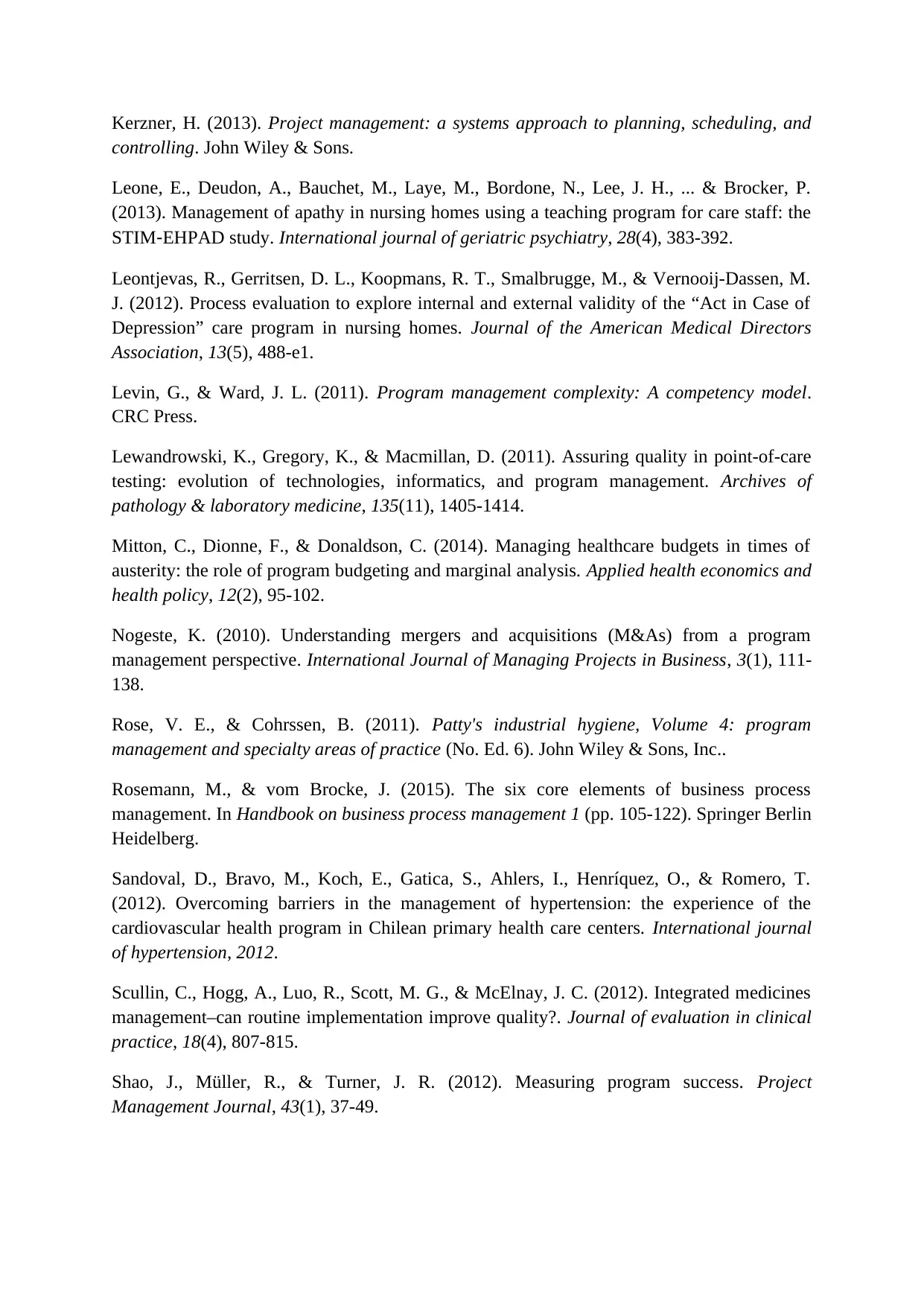
Kerzner, H. (2013). Project management: a systems approach to planning, scheduling, and
controlling. John Wiley & Sons.
Leone, E., Deudon, A., Bauchet, M., Laye, M., Bordone, N., Lee, J. H., ... & Brocker, P.
(2013). Management of apathy in nursing homes using a teaching program for care staff: the
STIM‐EHPAD study. International journal of geriatric psychiatry, 28(4), 383-392.
Leontjevas, R., Gerritsen, D. L., Koopmans, R. T., Smalbrugge, M., & Vernooij-Dassen, M.
J. (2012). Process evaluation to explore internal and external validity of the “Act in Case of
Depression” care program in nursing homes. Journal of the American Medical Directors
Association, 13(5), 488-e1.
Levin, G., & Ward, J. L. (2011). Program management complexity: A competency model.
CRC Press.
Lewandrowski, K., Gregory, K., & Macmillan, D. (2011). Assuring quality in point-of-care
testing: evolution of technologies, informatics, and program management. Archives of
pathology & laboratory medicine, 135(11), 1405-1414.
Mitton, C., Dionne, F., & Donaldson, C. (2014). Managing healthcare budgets in times of
austerity: the role of program budgeting and marginal analysis. Applied health economics and
health policy, 12(2), 95-102.
Nogeste, K. (2010). Understanding mergers and acquisitions (M&As) from a program
management perspective. International Journal of Managing Projects in Business, 3(1), 111-
138.
Rose, V. E., & Cohrssen, B. (2011). Patty's industrial hygiene, Volume 4: program
management and specialty areas of practice (No. Ed. 6). John Wiley & Sons, Inc..
Rosemann, M., & vom Brocke, J. (2015). The six core elements of business process
management. In Handbook on business process management 1 (pp. 105-122). Springer Berlin
Heidelberg.
Sandoval, D., Bravo, M., Koch, E., Gatica, S., Ahlers, I., Henríquez, O., & Romero, T.
(2012). Overcoming barriers in the management of hypertension: the experience of the
cardiovascular health program in Chilean primary health care centers. International journal
of hypertension, 2012.
Scullin, C., Hogg, A., Luo, R., Scott, M. G., & McElnay, J. C. (2012). Integrated medicines
management–can routine implementation improve quality?. Journal of evaluation in clinical
practice, 18(4), 807-815.
Shao, J., Müller, R., & Turner, J. R. (2012). Measuring program success. Project
Management Journal, 43(1), 37-49.
controlling. John Wiley & Sons.
Leone, E., Deudon, A., Bauchet, M., Laye, M., Bordone, N., Lee, J. H., ... & Brocker, P.
(2013). Management of apathy in nursing homes using a teaching program for care staff: the
STIM‐EHPAD study. International journal of geriatric psychiatry, 28(4), 383-392.
Leontjevas, R., Gerritsen, D. L., Koopmans, R. T., Smalbrugge, M., & Vernooij-Dassen, M.
J. (2012). Process evaluation to explore internal and external validity of the “Act in Case of
Depression” care program in nursing homes. Journal of the American Medical Directors
Association, 13(5), 488-e1.
Levin, G., & Ward, J. L. (2011). Program management complexity: A competency model.
CRC Press.
Lewandrowski, K., Gregory, K., & Macmillan, D. (2011). Assuring quality in point-of-care
testing: evolution of technologies, informatics, and program management. Archives of
pathology & laboratory medicine, 135(11), 1405-1414.
Mitton, C., Dionne, F., & Donaldson, C. (2014). Managing healthcare budgets in times of
austerity: the role of program budgeting and marginal analysis. Applied health economics and
health policy, 12(2), 95-102.
Nogeste, K. (2010). Understanding mergers and acquisitions (M&As) from a program
management perspective. International Journal of Managing Projects in Business, 3(1), 111-
138.
Rose, V. E., & Cohrssen, B. (2011). Patty's industrial hygiene, Volume 4: program
management and specialty areas of practice (No. Ed. 6). John Wiley & Sons, Inc..
Rosemann, M., & vom Brocke, J. (2015). The six core elements of business process
management. In Handbook on business process management 1 (pp. 105-122). Springer Berlin
Heidelberg.
Sandoval, D., Bravo, M., Koch, E., Gatica, S., Ahlers, I., Henríquez, O., & Romero, T.
(2012). Overcoming barriers in the management of hypertension: the experience of the
cardiovascular health program in Chilean primary health care centers. International journal
of hypertension, 2012.
Scullin, C., Hogg, A., Luo, R., Scott, M. G., & McElnay, J. C. (2012). Integrated medicines
management–can routine implementation improve quality?. Journal of evaluation in clinical
practice, 18(4), 807-815.
Shao, J., Müller, R., & Turner, J. R. (2012). Measuring program success. Project
Management Journal, 43(1), 37-49.
⊘ This is a preview!⊘
Do you want full access?
Subscribe today to unlock all pages.

Trusted by 1+ million students worldwide
1 out of 13
Related Documents
Your All-in-One AI-Powered Toolkit for Academic Success.
+13062052269
info@desklib.com
Available 24*7 on WhatsApp / Email
![[object Object]](/_next/static/media/star-bottom.7253800d.svg)
Unlock your academic potential
Copyright © 2020–2025 A2Z Services. All Rights Reserved. Developed and managed by ZUCOL.





